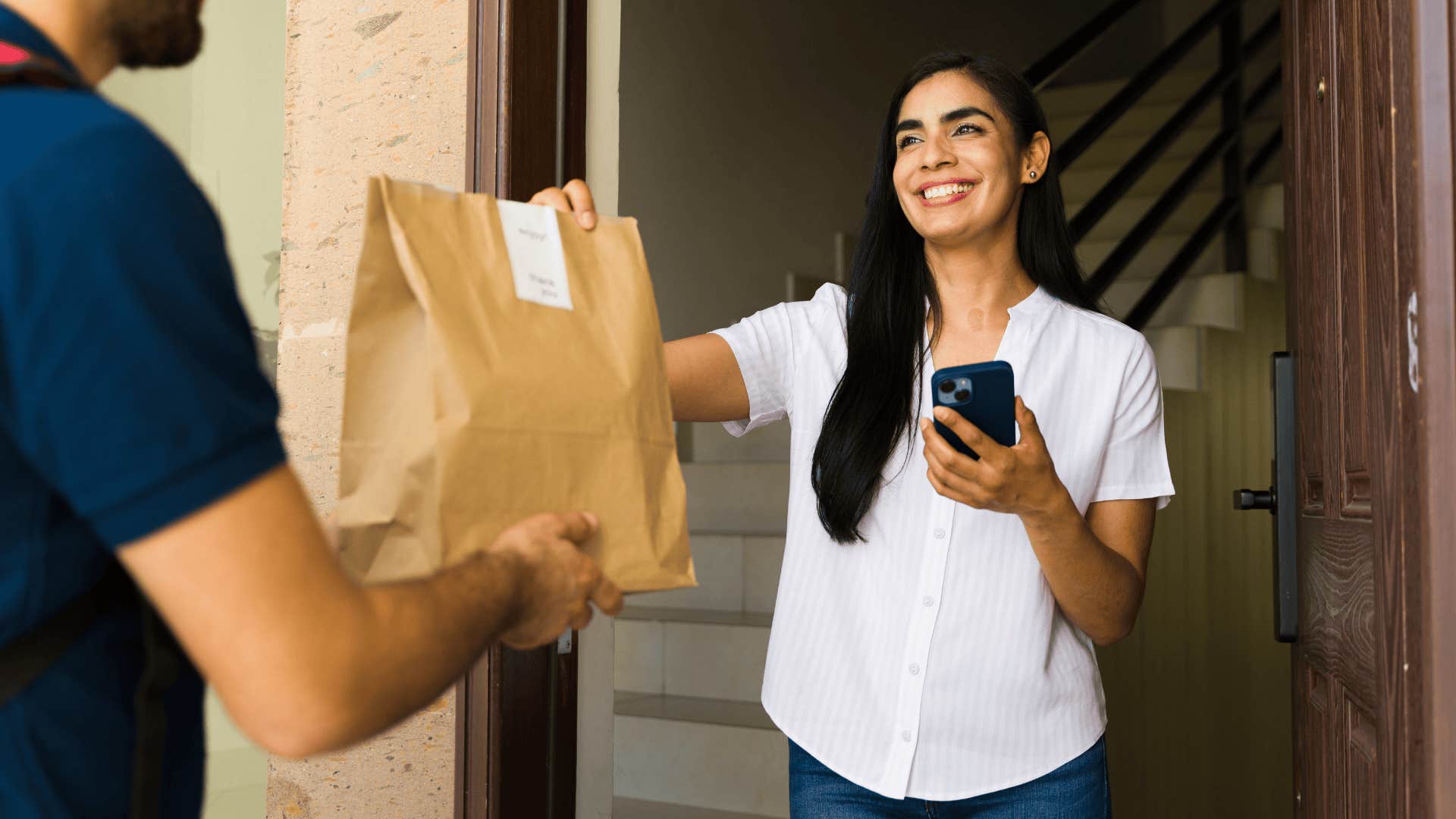12 Things Brilliantly Frugal People Stopped Buying Last Year
Saving money doesn't have to mean making major sacrifices.
 Ground Picture | Shutterstock.com
Ground Picture | Shutterstock.com Over a third of working families in the United States can’t afford basic necessities like groceries, rent, or utilities, according to Brandeis University researchers, so saving money for larger expenses like unexpected healthcare costs, a new vehicle, a home, or even college tuition has become increasingly unfeasible for a large portion of households. Of course, making sacrifices and sticking to a budget can be helpful for a bit of grace month-to-month, but generally speaking, these habits aren’t providing families with financial freedom or comfort.
However, opting for a lifestyle change, coupled with gaining some knowledge around financial literacy, can make a big difference for people in these financially struggling households — giving them the tools to save and spend with less anxiety. Even on a daily basis, there are things brilliantly frugal people stopped buying last year that encouraged them to shift their mindset around money and save for larger investments and the comfort they’re yearning for.
Here are 12 things brilliantly frugal people stopped buying last year
1. Bottled water
 StratfordProductions | Shutterstock.com
StratfordProductions | Shutterstock.com
According to a study conducted by Penn State University, the average American can save on average $1,236 per year by using a reusable water bottle instead of purchasing plastic bottles.
Of course, consuming water is a necessity, but going out of your way to purchase disposable bottles, when there are reusable options is largely a waste of money, which is why it was one of the things brilliantly frugal people stopped buying last year.
Outside of sheer financial benefits, reusable water bottles are also much more sustainable and healthy for the planet than their plastic alternatives. But, it’s important to build a routine around water consumption with a reusable bottle, like experts from the Cleveland Clinic suggest, as they can often become a breeding ground for bacteria if they’re left unwashed for extended periods of time.
2. Haircuts
 evrymmnt | Shutterstock.com
evrymmnt | Shutterstock.com
While cosmetic spending and appearance-driven consumption has become incredibly important not just in our culture, but to individuals, there are ways to cut back on spending that make a dramatic difference in the amount of money households are able to save every year. For example, the average person spends nearly $300 on haircuts alone annually, and women tend to spend much more per appointment.
Haircuts are one of the things brilliantly frugal people stopped buying last year, not because they’ve stopped actually cutting their hair, but because they've stopped paying other people to do it.
Learning a new skill, like cutting hair or painting your own nails isn’t just a long-term investment that saves money, it’s an intentional act of self-care that can help people to carve out space in their routines just for themselves. Of course, if this is one of your non-negotiables, something that brings you genuine joy and reprieve from the stress of your routine, don’t feel pressured to give it up because other people are comfortably doing so.
3. Real Christmas trees
 Impact Photography | Shutterstock.com
Impact Photography | Shutterstock.com
Depending on the size and variety of the tree, a real Christmas tree can cost anywhere from $50 to $400. While an artificial tree may hover around the same price point, it can be a cost-saving measure for families who are reusing the same tree every year.
Christmas trees are one of the things brilliantly frugal people stopped buying last year, not just because they were struggling with affording basic necessities at the moment and hoping to cut back on optional spending, but because they’re thinking from a long-term mindset about their investments.
If you’re making the investment on something like a Christmas tree or holiday decorations, why not spend the money on something that you can continue to reuse and love for more than one season? Don’t worry, there’s plenty of candles and plug-in air fresheners that are perfectly affordable for re-creating the nostalgic pine smell.
4. Food delivery services
 Antoniodiaz | Shutterstock.com
Antoniodiaz | Shutterstock.com
According to a survey conducted by Upgraded Points, more than 75% of Americans have used a food delivery service occasionally over the past year and the average consumer wracks up more than $1,500 in food delivery purchases on platforms like Uber Eats or DoorDash annually.
While spending on convenience every once in a while is often an expense you can’t avoid, relying on these platforms regularly, rather than meal-prepping or intentionally buying groceries, can significantly add up.
Especially now that platforms are leveraging people’s desire for convenience and inadvertently taking advantage of their lacking financial literacy — for example, DoorDash’s collaboration with Klarna, letting consumers order food and pay afterward — it’s important to understand and be self-aware about where you’re spending your money and alternative money-saving strategies that can set you up for long-term success.
5. Holiday decorations
 YAKOBCHUK VIACHESLAV | Shutterstock.com
YAKOBCHUK VIACHESLAV | Shutterstock.com
While celebrating holidays and getting festive with decorations is largely a tradition people are willing to invest in, opting for investments that can be reused and recycled is one of the best ways to spend money. According to chief editor of Top Trends Guide, Ana Roberts, buying any kind of single-use decorations — like festive tableware, overly specific decorations, or brand new ornaments — is a waste of money.
While fast decorations and store-bought items are one of the things brilliantly frugal people stopped buying last year, they’re not completely missing out on the fun. By opting for “DIY” decorations, they not only save money, but create new traditions and moments of quality time with their families outside the realm of consumerism.
6. Multiple streaming services
 La Famiglia | Shutterstock.com
La Famiglia | Shutterstock.com
Rather than juggling multiple streaming services, “choice overload,” and an alarming bill month-to-month, one of the things brilliantly frugal people stopped buying last year was more than one entertainment service.
By choosing one specific streaming service, they not only eliminated the accumulative costs every month of having a few, but made choosing a show or movie at the end of the day less overwhelming and unnecessarily anxiety-inducing.
Cutting out the guilt of not using all of their services regularly, these brilliantly frugal households have more time to spend enjoying entertainment, rather than stressing about finding something to watch and paying for things they weren’t even using.
7. Physical books
 mentatdgt | Shutterstock.com
mentatdgt | Shutterstock.com
While physical books often prove better for reading comprehension and reader experience than digital options, they tend to be much more expensive than monthly subscriptions on reading devices like a Kindle or cellphone apps. Especially if you’re an avid reader, buying more than 10 books a year at an average price of around $20 you’re already spending nearly $200 annually.
By opting for a monthly reading subscription with a catalog of books to pick from, that tend to range in price from $8 to $20 monthly, you not only expand your options, but remove the burden of transportation and print book costs on your spending habits as a whole.
Even if you make an effort to buy books secondhand or from thrift stores, rather than a major reseller or online, you’ll save a great deal of money every year, without having to sacrifice a hobby that adds to your quality of life.
8. Salad dressing
 Prostock-studio | Shutterstock.com
Prostock-studio | Shutterstock.com
According to Dr. Ann Kulze, the founder of Just Wellness, opting to make your own salad dressing instead of purchasing bottles from the store is not only better for your wallet, but beneficial to your health and the environment.
By experimenting with homemade recipes that are not just simple and easy, but made of low-cost ingredients you can buy in bulk, brilliantly frugal people avoid spending unnecessary money on bottled salad dressing. They can spice up their meals and add excitement to their plain groceries by making sauces of all kinds — kept in bulk or made on the spot in their kitchen.
9. Paper products
 Gorodenkoff | Shutterstock.com
Gorodenkoff | Shutterstock.com
While opting for paper products like paper plates and cups can be a convenience, especially for households without a dishwasher or the time to keep up with ceramic dishes, there are other products, like tissues or paper towels that brilliantly frugal people choose not to buy anymore.
By swapping out disposable products for reusable ones like handmade, washable tissues or reusable paper towels, frugal people can save more than $200 annually, according to a Statistica survey.
Of course, convenience, in some cases, is more important than saving a couple hundred dollars, but when combined with the other things brilliantly frugal people stopped buying last year, households can save thousands better directed toward long-term goals, savings accounts, or investments like a new car.
10. Makeup wipes
 Yaroslav Astakhov | Shutterstock.com
Yaroslav Astakhov | Shutterstock.com
Considering makeup wipes tend to cost on average around 25 cents per wipe, households can save a ton of money by opting for “DIY” options or by investing in bulk makeup removing solution and reusable cloths, rather than continuing to purchase overpriced — and overpackaged – wipes.
Many people, even the most frugal individuals, fall into the habit of investing in products marketed towards convenience. While it can be tempting to opt for makeup wipes, rather than using a cloth and having to wash it later, making a deliberate choice to put in a few minutes of extra effort for long-term saving can add up.
Like many of the other things brilliantly frugal people stopped buying last year, deciding not to spend on products like makeup wipes is a mindset shift — to reach your financial goals, what changes can you make, without sacrificing things you enjoy or expenditures you’re reliant upon?
11. Cans of soda
 Viacheslav Boiko | Shutterstock.com
Viacheslav Boiko | Shutterstock.com
In a four-person household that regularly drinks soda from the grocery store, it’s easy to spend more than $1K on soda alone in a single year. Of course, when you’re at the grocery store, picking up a 12-pack of Diet Coke, that doesn't typically cross your mind, but it’s what fuels many of the deliberate choices and things brilliantly frugal people stopped buying last year.
Even once-cheap options like a $1 large Diet Coke from McDonald’s isn’t saving people money anymore, with fast food prices skyrocketing and grocery costs lingering alongside them. Here’s where the brilliantly frugal mindset comes into play — are you willing to look out for your wallet and health by cutting back on something like Diet Coke? Are you willing to make it a treat, rather than a necessity, and save money for other expenditures?
Completely giving up these small luxuries hardly ever makes a difference — sparking guilt in people over spending money — but being more intentional about how and when you buy them can spark healthy and effective change.
12. New clothing
 maxbelchenko | Shutterstock.com
maxbelchenko | Shutterstock.com
According to data from the U.S. Bureau of Labor Statistics, the average consumer can spend nearly $2K on apparel and new clothing annually. While some of the purchases, like a new winter jacket, boots for the kids, or replacing unwearable items, is necessary, there are other options to cut back on this massive expenditure.
Whether you’re adopting a hobby like sewing to rewear and reimagine old clothing, shopping secondhand or at thrift stores, or shifting your mindset about when it’s truly necessary to buy new clothes, being mindful about careless spending on things like fast fashion can help your wallet, your mental health, and the environment long-term.
Zayda Slabbekoorn is a staff writer with a bachelor’s degree in social relations & policy and gender studies who focuses on psychology, relationships, self-help, and human interest stories.

